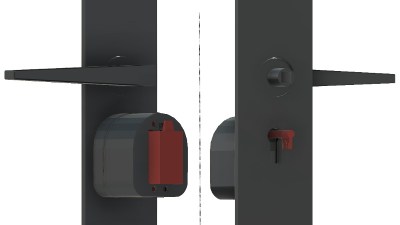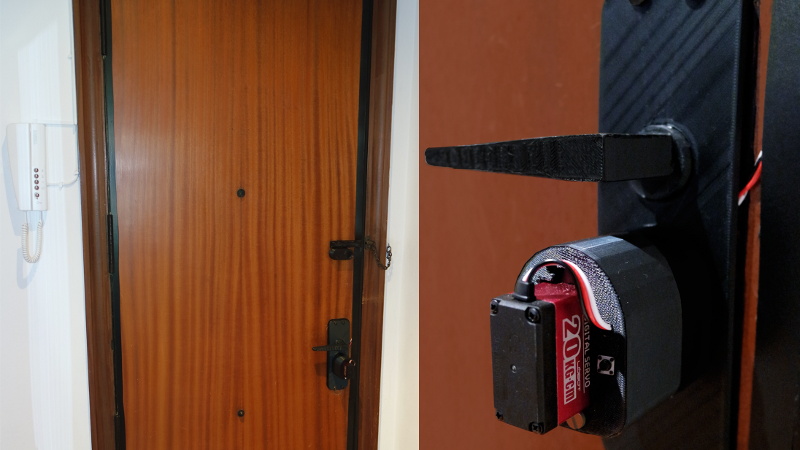[Madalin Valceleanu] had a somewhat unique problem. He wanted to make his front door a bit “smarter”, but none of the IoT door locks he found were compatible with the style of reinforced door he had. So he set out to design and 3D print his own Internet-controlled door handle.
Now we say handle and not lock because the internal mechanisms haven’t actually been replaced. Those aren’t exactly the kind of parts that lend themselves to being recreated in PLA, after all. The printed components simply replace the original plate and handle on the interior of the door.
 In that case, you might be wondering what the point of all this was. If he’s still using the same internal mechanism, how does a new handle help? On his new handle, [Madalin] has integrated a servo that’s capable of turning the original key in the door. With the servo wired up to a Raspberry Pi, this allows him to lock and unlock the door through his home automation system.
In that case, you might be wondering what the point of all this was. If he’s still using the same internal mechanism, how does a new handle help? On his new handle, [Madalin] has integrated a servo that’s capable of turning the original key in the door. With the servo wired up to a Raspberry Pi, this allows him to lock and unlock the door through his home automation system.
[Madalin] has made the STLs for his printed handles available on Thingiverse, but like most of these “bolt on” style door modifications, we imagine the design is bespoke enough that it won’t be much practical use to anyone else. Still, it’s an excellent example of solving a real-world problem with some outside of the box thinking.
















Madalin has obviously put a lot of thought and effort into this design and thats great.
But I would suspect printing an entire door lock mechanism out of PLA would probably be relatively strong enough for an IOT door lock.
Well if you want a “bolt on” lock system, just use a bolt lock, if you can turn a key you can easily push and pull a bolt.
This looks a bit worrisome in that it may allow the key to be turned with a tool from the other side of the door, unless the external keyhole is blanked off securely, or it’s one of those double cylinder types.
Somebody’s going to be that guy in this thread, so it may as well be me:
Unfortunately, a plastic door handle is a really, really serious safety hazard. If the handle goes all soft and mushy because there’s a fire in the home and the door handle’s been heated up a little bit, there’s no way to leave. Or if someone hits the handle hard in a panic to exit, they could snap it right off and also have no way to leave.
The National Fire Protection Association publishes standards for the construction of doors and windows. See [https://www.nfpa.org/codes-and-standards/all-codes-and-standards/list-of-codes-and-standards/detail?code=80 NFPA-80] for the relevant information.
Why do you say there’s no way to leave? Just turn the key.
Do you mean you think the plastic in a fire would melt on the key and make it too hot to touch? Since the key is metal you’d have the problem of metal heating up even without this.
I did a search for “key” and “lock” on the page you linked to, nothing is found. I can’t believe it would even be up to the fire protection association to dictate the owner can’t leave the key inside the lock.
If you leave the key in the lock, anyone can unlock it to get out. If he kept it on his keyring instead, no one but he could unlock it to get out. That’s assuming in a fire he remembers to grab the keys :P
Fire be damned, what about if the power goes out for an extended period? I see he mentioned some kind of ‘electric accumulator’ for emergencies, but I don’t see any kind of failsafe in the overall design to access the key if the electronics stop working.
Hey, i’ve build exactly the same… how do you handle the complete failure of the system? How do you want to open the door if the key from another side blocks the insertion of the key from outside? I though to solve this problem with a special lock that allows a usage of two keys from both sides simultaneously. So if the internal key doesn’t rotate anymore, you can still open the door manually from outside with your second key.
That’s what back doors are for